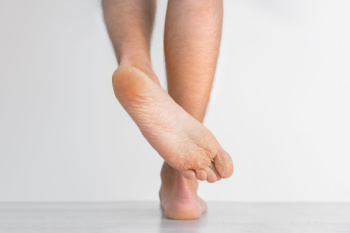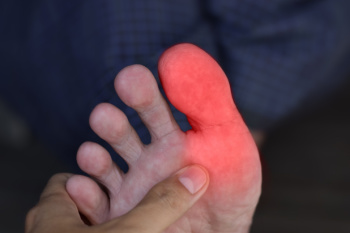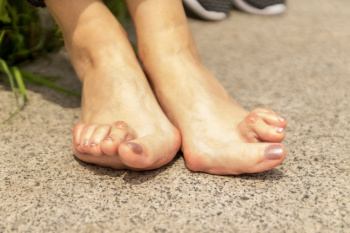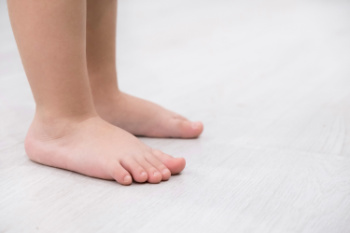Connect With Us
Blog
Items filtered by date: August 2025
Reasons Athlete’s Foot Can Recur

Athlete’s foot is a stubborn fungal infection that affects the skin on the feet, especially between the toes. It is caused by fungi that thrive in warm, moist environments, such as sweaty socks, shoes, or public places like locker rooms and around swimming pools. Symptoms include itching, burning, redness, peeling skin, and sometimes blisters or cracking, which can cause discomfort and make walking painful. Athlete’s foot often recurs because the fungi are difficult to completely eliminate and can survive in shoes, socks, or on skin, especially if moisture and warmth persist. Poor foot hygiene, wearing tight shoes, or not fully treating the infection also contribute to recurrence. A podiatrist can diagnose athlete’s foot by examining the affected skin and samples may be taken to confirm the fungal infection. Treatment includes antifungal creams, powders, and advice on proper foot care and hygiene to prevent reinfection. If you have athlete's foot that keeps recurring, it is suggested that you schedule an appointment with a podiatrist. for effective treatment solutions, which may include prescribed medication.
Athlete’s Foot
Athlete’s foot is often an uncomfortable condition to experience. Thankfully, podiatrists specialize in treating athlete’s foot and offer the best treatment options. If you have any questions about athlete’s foot, consult with Richard M. Allen, DPM from Idaho. our doctor will assess your condition and provide you with quality treatment.
What Is Athlete’s Foot?
Tinea pedis, more commonly known as athlete’s foot, is a non-serious and common fungal infection of the foot. Athlete’s foot is contagious and can be contracted by touching someone who has it or infected surfaces. The most common places contaminated by it are public showers, locker rooms, and swimming pools. Once contracted, it grows on feet that are left inside moist, dark, and warm shoes and socks.
Prevention
The most effective ways to prevent athlete’s foot include:
- Thoroughly washing and drying feet
- Avoid going barefoot in locker rooms and public showers
- Using shower shoes in public showers
- Wearing socks that allow the feet to breathe
- Changing socks and shoes frequently if you sweat a lot
Symptoms
Athlete’s foot initially occurs as a rash between the toes. However, if left undiagnosed, it can spread to the sides and bottom of the feet, toenails, and if touched by hand, the hands themselves. Symptoms include:
- Redness
- Burning
- Itching
- Scaly and peeling skin
Diagnosis and Treatment
Diagnosis is quick and easy. Skin samples will be taken and either viewed under a microscope or sent to a lab for testing. Sometimes, a podiatrist can diagnose it based on simply looking at it. Once confirmed, treatment options include oral and topical antifungal medications.
If you have any questions, please feel free to contact our office located in Lewiston, ID . We offer the newest diagnostic and treatment technologies for all your foot care needs.
Causes of Pain in the Big Toe

Discomfort in the big toe can stem from a range of issues, some developing gradually and others appearing suddenly. Arthritis, particularly in the joint at the base of the toe, can cause stiffness, swelling, and aching. Bunions may create pain by shifting the toe’s position and increasing pressure against footwear. Injuries such as sprains, fractures, or turf toe can result in immediate pain and swelling. Gout, a form of inflammatory arthritis, often brings intense and sudden pain along with redness and warmth in the joint. Even ingrown toenails can lead to tenderness and difficulty wearing shoes. Identifying the underlying cause is vital to finding the right treatment and preventing further complications. If you notice persistent pain, swelling, or changes in your big toe, it is suggested you seek care from a podiatrist for an accurate diagnosis and appropriate treatment solutions.
Toe pain can disrupt your daily activities. If you have any concerns, contact Richard M. Allen, DPM of Idaho. our doctor can provide the care you need to keep you pain-free and on your feet.
What Causes Toe Pain?
Most severe toe pain is caused due to a sports injury, trauma from dropping something heavy on the toe, or bumping into something rigid. Other problems can develop over time for various reasons.
Toe pain can be caused by one or more ailments. The most common include:
- Trauma
- Sports injury
- Wearing shoes that are too tight
- Arthritis
- Gout
- Corns and calluses
- Hammertoe
- Bunions
- Blisters
- Ingrown toenails
- Sprains
- Fractures (broken bones)
- Dislocations
When to See a Podiatrist
- Severe pain
- Persistent pain that lasts more than a week
- Signs of infection
- Continued swelling
- Pain that prevents walking
Diagnosis
In many cases the cause of toe pain is obvious, but in others, a podiatrist may want to use more advanced methods to determine the problem. These can range from simple visual inspections and sensation tests to X-rays and MRI scans. Prior medical history, family medical history, and any recent physical traumatic events will all be taken into consideration for a proper diagnosis.
Treatment
Treatments for toe pain and injuries vary and may include shoe inserts, padding, taping, medicines, injections, and in some cases, surgery. If you believe that you have broken a toe, please see a podiatrist as soon as possible.
If you have any questions please contact our office located in Lewiston, ID . We offer the newest diagnostic and treatment technologies for all your foot and ankle needs.
Rheumatoid Arthritis in the Foot and How a Podiatrist Can Help

Rheumatoid arthritis is a chronic autoimmune condition that causes inflammation in the joints, including those in the foot. This inflammation can lead to pain, swelling, stiffness, and deformities that affect mobility and quality of life. Risk factors include family history, gender, age, and smoking. Early diagnosis and treatment are essential to managing symptoms and preventing joint damage. A podiatrist plays a vital role in treating rheumatoid arthritis in the foot by providing custom orthotics, managing pain, and monitoring joint health. If you have rheumatoid arthritis and experience persistent foot pain or stiffness, it is suggested that you are under the care of a podiatrist who can offer effective relief and management tips.
Because RA affects more than just your joints, including the joints in your feet and ankles, it is important to seek early diagnosis from your podiatrist if you feel like the pain in your feet might be caused by RA. For more information, contact Richard M. Allen, DPM of Idaho. our doctor will assist you with all of your podiatric concerns.
What Is Rheumatoid Arthritis?
Rheumatoid Arthritis (RA) is an autoimmune disorder in which the body’s own immune system attacks the membranes surrounding the joints. Inflammation of the lining and eventually the destruction of the joint’s cartilage and bone occur, causing severe pain and immobility.
Rheumatoid Arthritis of the Feet
Although RA usually attacks multiple bones and joints throughout the entire body, almost 90 percent of cases result in pain in the foot or ankle area.
Symptoms
- Swelling and pain in the feet
- Stiffness in the feet
- Pain on the ball or sole of feet
- Joint shift and deformation
Diagnosis
Quick diagnosis of RA in the feet is important so that the podiatrist can treat the area effectively. Your doctor will ask you about your medical history, occupation, and lifestyle to determine the origin of the condition. Rheumatoid Factor tests help to determine if someone is affected by the disease.
If you have any questions, please feel free to contact our office located in Lewiston, ID . We offer the newest diagnostic and treatment technologies for all your foot care needs.
Ease Painful Feet With Orthotics

Custom orthotics can be used to relieve foot pain and discomfort. They're also used to treat various foot conditions and deformities. Flat feet, bunions, and Morton's neuroma are just a few of the foot conditions that have been known to benefit from the use of orthotics.
Comfy feet are happy feet! Contact us today.
Causes and Symptoms of Flat Feet in Babies

Flat feet in babies and children are common and usually a normal part of early development. Symptoms include feet that appear flat when standing, uneven shoe wear, or difficulty with balance as the child begins to walk. This condition often results from undeveloped arches, flexible joints, or inherited traits. While many cases resolve naturally as the child grows, some may benefit from early evaluation. A podiatrist can assess foot structure, provide stretching exercises, and recommend proper footwear or orthotics, if needed. If you notice your baby or child is walking differently or showing signs of discomfort, it is suggested that you consult a podiatrist. Early guidance can support healthy development and prevent future foot or gait concerns.
Flatfoot is a condition many people suffer from. If you have flat feet, contact Richard M. Allen, DPM from Idaho. our doctor will treat your foot and ankle needs.
What Are Flat Feet?
Flatfoot is a condition in which the arch of the foot is depressed and the sole of the foot is almost completely in contact with the ground. About 20-30% of the population generally has flat feet because their arches never formed during growth.
Conditions & Problems:
Having flat feet makes it difficult to run or walk because of the stress placed on the ankles.
Alignment – The general alignment of your legs can be disrupted, because the ankles move inward which can cause major discomfort.
Knees – If you have complications with your knees, flat feet can be a contributor to arthritis in that area.
Symptoms
- Pain around the heel or arch area
- Trouble standing on the tip toe
- Swelling around the inside of the ankle
- Flat look to one or both feet
- Having your shoes feel uneven when worn
Treatment
If you are experiencing pain and stress on the foot you may weaken the posterior tibial tendon, which runs around the inside of the ankle.
If you have any questions, please feel free to contact our office located in Lewiston, ID . We offer the newest diagnostic and treatment technologies for all your foot care needs.
